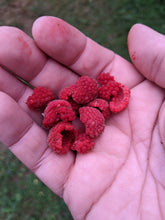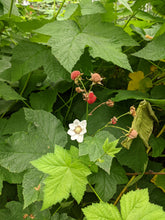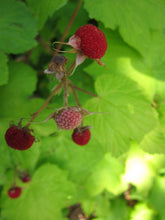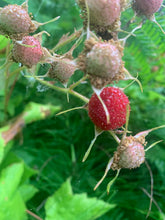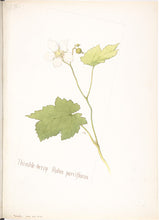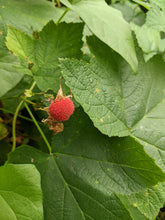Thimbleberry
Regular price
$5.00
Sale
Rubus parviflorus
Origin: Washington State
Improvement status: Wild
Seeds per packet: ~100
BOTANICAL SAMPLE - NOT GERMINATION TESTED
Life cycle: Perennial
Thimbleberries are much-sought-after wild cousins of raspberries with a delicious flavor and minuscule seeds (unlike most of their Rubus relatives). EFN co-founder Nate Kleinman, while in high school, spent a summer doing trail-work at Pictured Rocks National Lakeshore on Michigan's Upper Peninsula. That was where he first encountered thimbleberries — near the eastern extreme of their range, incidentally — and he's been entranced by them ever since. The flavor is sweet and tart, certainly reminiscent of raspberries, but with strawberry undertones too, and sometimes something almost tropical. The small seeds are so unobtrusive as to be almost non-existent, making them great for people who avoid raspberries and blackberries because they can't stand the seeds. On Michigan's Leelanau Peninsula, one small company makes a delicious thimbleberry jam which costs about 5 times more than raspberry jam.
Thimbleberries have an eastern North American cousin, the so-called purple-flowering raspberry (Rubus odoratus) that very much resembles the western thimbleberry, but is just not as good (it has smaller berries, is a less reliable fruiter, and is even pickier about habitat). These western thimbleberries have white flowers. Both species have broad leaves that more resemble maple leaves than raspberry or blackberry leaves, and both grow into large bushes. They prefer damp, partially or nearly fully shady environments — in the dappled light of a transitional forest clearing, or the damp north-facing slope of a roadside. Each plant produces just a handful of fruit, which is why this species is rarely cultivated for food: it would take too much area to produce a large amount. But as a foraged food, it's truly unparalleled.
Our seed comes from Washington state, via the good folks at Sheffield's Seed Company in Locke, NY. You can bet Nate will be trying to grow some this year alongside all of you!
GROWING TIPS: Seeds require 90 days warm stratification followed by 90 days of cold stratification. Sow just below the surface of nice soil and tamp down. Keep young plants well-weeded and moist. Find a nice partially shade spot — thimbleberries love living on edges, forest edges, roadside edges, pond edges — and let them do their thing.







